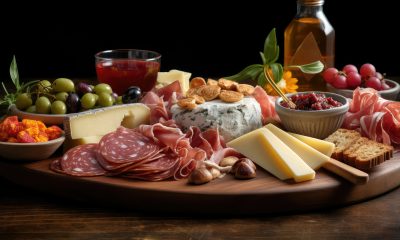Spanish Cuisine
Cheese and Olive Oil Across Spain
Spain, with its diverse landscapes and climates, is a treasure trove of gastronomic delights.
Among its most prized products are its cheese and olive oil, each with distinct regional characteristics that reflect the country’s rich culinary heritage.
This article explores the variety of Spanish cheese and olive oil, highlighting their origins, production methods, and unique flavors from different areas of Spain.
Spanish Cheese: A Regional Delight
Spain boasts a remarkable variety of cheeses, each with unique flavors and textures shaped by the local environment and traditional methods.
Here are some of the most notable cheeses from various regions:
Origin Manchego – Castilla-La Mancha
Manchego is perhaps the most famous Spanish cheese, originating from the La Mancha region in central Spain.
It is made from the milk of Manchega sheep, which graze on the region’s dry plains.
Characteristics:
Texture:
Firm and compact with a buttery texture.
Flavor:
Mild, nutty flavor that becomes more pronounced and tangy with age.
Aging:
Ranges from fresh (fresco) to aged (curado), with aged varieties developing a more intense flavor.
Uses:
Manchego is versatile, enjoyed on its own, in tapas, or as an ingredient in dishes like salads and soups.
Origin Cabrales – Asturias
Cabrales is a blue cheese from the Asturias region in northern Spain, where it is traditionally aged in limestone caves in the Picos de Europa mountains.
Characteristics:
Texture:
Creamy and dense.
Flavor:
Strong, pungent, and slightly spicy, with a distinctive blue mold.
Aging:
Aged for several months in natural caves, which contribute to its unique flavor profile.
Uses:
Cabrales is often served with cider, honey, or membrillo (quince paste) and is used in sauces and spreads.
Origin: Mahón – Menorca, Balearic Islands
Mahón cheese comes from the island of Menorca in the Balearic Islands, made from cow’s milk and named after the island’s main port.
Characteristics:
Texture:
Semi-hard to hard, with a buttery and creamy texture.
Flavor:
Slightly salty and tangy, with a fruity aroma.
Aging:
Varies from fresh (tierno) to aged (curado), with aged varieties developing a more complex flavor.
Uses:
Mahón is often grated over pasta, used in sandwiches, or paired with cured meats and olives.
Spanish Olive Oil: Liquid Gold from Different Regions
Spain is the world’s largest producer of olive oil, known for its high quality and diverse range of flavors.
Here are some of the most prominent olive oil-producing regions and their distinctive oils:
Andalusia
Varieties:
Picual:
The most common variety, known for its robust flavor, high polyphenol content, and slightly bitter, peppery finish.
Hojiblanca:
Offers a milder, fruitier flavor with hints of apple and almond.
Arbequina:
Known for its smooth, sweet, and buttery flavor.
Characteristics:
Andalusian olive oils are highly regarded for their versatility, used in everything from cooking and frying to dressings and dips.
Catalonia
Varieties:
Arbequina:
The primary variety, producing a light, fruity, and aromatic oil with a delicate flavor.
Characteristics:
Catalonian olive oil is known for its high quality and is often used in salads, drizzled over vegetables, or as a finishing oil.
Castilla-La Mancha
Varieties:
Cornicabra:
The main variety, known for its balanced flavor with fruity and slightly bitter notes, and a peppery finish.
Characteristics:
Olive oil from Castilla-La Mancha is versatile, suitable for both cooking and raw applications, such as dressings and marinades.
Extremadura
Varieties:
Manzanilla Cacereña:
A unique variety producing a smooth, fruity oil with a hint of bitterness and a peppery aftertaste.
Characteristics:
Extremaduran olive oil is prized for its unique flavor profile, often used in gourmet dishes and to enhance the taste of traditional Extremaduran cuisine.
Navarra
Varieties:
Arróniz:
The primary variety, known for its intense, fruity flavor with a slightly bitter and spicy finish.
Characteristics:
Navarran olive oil is often used in local dishes, drizzled over roasted vegetables, or served with rustic bread.
Conclusion
The diversity of Spanish cheese and olive oil reflects the rich agricultural heritage and culinary traditions of the country.
From the nutty flavors of Manchego in Castilla-La Mancha to the robust Picual olive oil of Andalusia, each product tells a story of its region’s landscape, climate, and cultural practices.
Whether enjoyed on their own or as part of traditional dishes, Spanish cheese and olive oil offer a taste of the country’s gastronomic excellence and are a testament to
Spain’s dedication to quality and tradition in food production.
